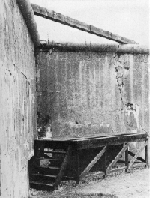Nazi Transit Camps: Breendonck
The fort of Breendonck is located along the old highway Brussels - Anvers [Antwerpen]. It is perhaps the only camp which remains totally intact. Breendonck was first a military fort and the buildings are built using reinforced concrete. For the German occupation administration, Breendonck was a "waiting" camp (Auffangslager) designed to receive Jews and political prisoners before their transfer to Germany. The first prisoners arrived on December 20th, 1940 . At this time, the guards were members of the Wehrmacht. In the beginning, the conditions of life were very difficult but not so hard as in the German concentration camps. But after the German troops invaded Russia (June 1941), the guards were replaced by German and Belgian SS and the atrocities became exactly the same as in any other Nazi camp. The lack of food became so severe that several prisoners tried to eat grass. Executions by hanging or shooting were common. The cruelest Belgian SS guards were Wijss, De Bodt and Pelleman.
 The gallows at Breendonck |
The prisoners had to live in bunkers built of concrete. These bunkers were very cold and damp and the Nazis provided only two simple chamber pot for twenty prisoners. In 1940 and at the beginning of 1941, it was "forbidden" to be ill.
The number of prisoners varied from between 30 and 600. Breendonck was small, compared to other camps, but the miserable conditions and the barbaric atrocities were exactly the same as in other Nazi camps. Tortures, hangings and shootings were common in Breendonck. The exact number of victims of Breendonck is unknown but latest researches proves that there were at least 3,000 deaths..
Breendonck had been evacuated first on May 6, 1944, and all the prisoners transferred to Germany. Later, more Belgium citizens were imprisoned in Breendonck. The camp was finally closed on August 30, 1944, and all the prisoners transferred to Vught in Holland and later to Germany. The Allied troops arrived to Breendonck on September 3, 1944. The camp was empty.
The fort of Breendonck was transformed in National Memorial in 1947. It is located not far from the center of Willebroek, a small town 15,5 miles from Brussels. Opening hours are 9 a.m. to 6 p.m. from April 1st to September 30th and 10 a.m. to 5 p.m. from October 1st to March 31th. The entrance fee is 75 Fb (+- 2 US $). The museum is closed from December 25th to January 1st. (mailing address: Mémorial National du Fort de Breendonck, B 2830, Willebroek, Tel.: 32-3-886 6209).
Sources: The Forgotten Camps


